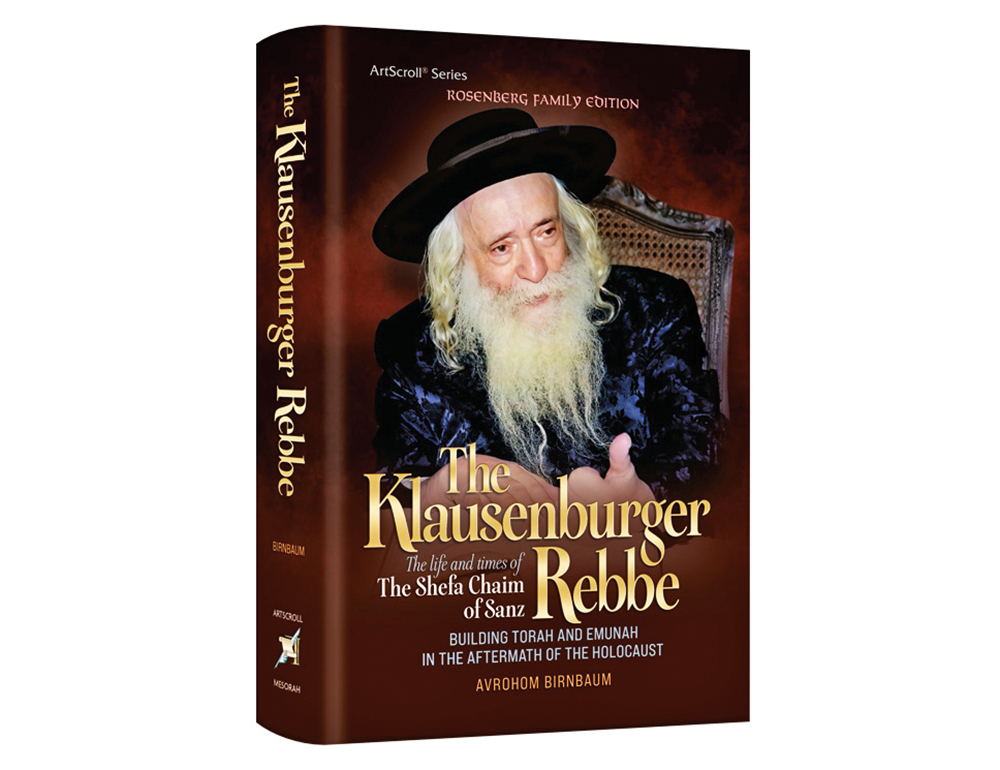
Highlighting: “The Klausenburger Rebbe: Building Torah and Emunah in the Aftermath of the Holocaust,” by Rabbi Avrohom Birnbaum. Mesorah Publications Ltd. 2024. Hardcover. 524 pages. ISBN-13: 978-1422640302.
(Courtesy of Artscroll) During and after World War II, a leader of exceptional stature emerged in Klal Yisrael. He was a dynamo, a brilliant talmid chacham who displayed unwavering dedication to Hashem and His people, and above all, unparalleled self-sacrifice. He was Rav Yekusiel Yehudah Halberstam, the Klausenberger Rebbe.
Despite enduring unspeakable personal tragedies, he ascended to remarkable spiritual heights while inspiring his suffering brethren. His indomitable spirit continued to inspire fellow survivors, offering hope and illuminating faith in a world shrouded in darkness.
In this meticulously researched and powerfully written biography, the reader encounters this extraordinary figure, whose unwavering faith served as a beacon, single-handedly drawing thousands to Torah observance and rebuilding the Torah world. He instituted programs like Mifal Hashas that were revolutionary and transformative. His private avodat Hashem seemed superhuman, as he spent hours on end immersed in Torah learning and tefillah, inspiring other toward greater spiritual aspirations.
The Rebbe wore many hats: He was a rav who paskened shaliat, a rosh yeshiva who delivered shiurim, and a rebbe who accepted kvitlach, guided chasidim and dispensed brachot, and a father and mother to countless broken survivors.
During the first decades after the war, the rebbe’s constant chesed on behalf of the survivors superseded anything else. From the most mundane aspects of obtaining food, visas, money to enable them to get married, worrying about a sheitel for a kallah, rebuilding chederim and yeshivot, the rebbe’s every waking moment was completely devoted to chesed for others, to the point where he temporarily relinquished his own spiritual goals.
What for most people would have been dayenu, ”enough,” was never enough for the rebbe. When he had satisfactorily built the mosdos in the DP camps, he did not say dayenu, but set his sights on America. Then he began to branch out to Montreal, South America and many other places where he saw a need. Even then he did not say dayenu. Instead, he turned his eyes toward Eretz Yisrael with the dream of building up the entire country and populating it with God-fearing Jews.
When enough mosdos were established, he turned his gaze toward providing inexpensive housing so young couples would be free to pursue spiritual goals and not be mired in budgetary concerns. Later, he built orphanages for children and old-age homes, as well as a hospital for the sick and infirm.
He was pure chesed.
He raised copious sums for these projects and traveled the world at great personal sacrifice. He raised millions of dollars, keeping absolutely nothing for himself. He even insisted on paying rent for his apartment in Union City, New Jersey that was located in the yeshiva building. Millions of dollars passed through his hands, but he lived frugally and simply, not wasting money on unnecessary items.
This devotion to chesed and to filling the needs of Klal Yisrael was already evident in his younger years when he was a rav in pre-war Klausenburg. His gabbai, Rabbi Shmuel Pollack, related the following story: A destitute widow once came to the rebbe crying bitterly. “I have no money,” she sobbed, “and my daughter is getting married tonight. However, I don’t even have money to buy her the most basic necessities that a kallah brings into the house, such as bedding, towels and the like.”
The Rebbe was in a quandary. He also didn’t have a penny in the house. “You know what?” he told the woman. “Tell the kallah to come to my house a bit later with an empty wagon. She should make sure the wagon is parked right under my upstairs window.” Then, he instructed Rabbi Pollackl to make sure that when she came no one would be looking. The wagon came and the rebbe himself went upstairs and began taking his own sheets, blankets, pillows and towels, and those of his children. He literally tossed them out the open window straight into the wagon.
Now the widow could bring her daughter to the chuppah with a light heart.
As for the Rebbe’s family? They were surprised to discover that all their pillows, blankets and sheets had disappeared and they would have to make do until the money to buy new ones materialized.
The rebbe’s devotion to chesed was rooted in his illustrious ancestor, the Divrei Chaim of Sanz, who would never go to sleep if there was even one penny left in the house. Every single coin that the Divrei Chaim received had to be distributed to tzedaka that same day. The Klausenburger Rebbe followed in his path. Any money that came his way, whether for kvitlach or through fundraising, was consecrated for the various tzedaka causes and mosdos that he had built and for which he had assumed responsibility.
Indeed, he was kulo chesed. Read the biography and learn of the unfathomable heights to which a human being can reach.








